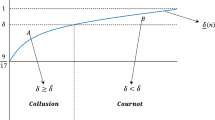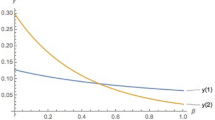Implications and summary
The objective of this paper is to investigate the assertion that a given rent payoff gives rise to an equal value of total expenditure. An analogy with perfect competition suggests a long-run perspective, which would allow the number of players to vary. Accordingly, a game theoretic model of the competitive process where competitors anticipate rival reactions and expend resources to increase their probability of winning is extended to include entry. Long-run quilibrium occurs when the incentive for entry is dissipated, i.e., expected profits equal 0 or the expected rate of return equals the opportunity cost discount rate. When this occurs total expenditure in rent-seeking is found to equal the payoff as in the standard competitive case.
How does this result affect Tullock's policy recommendations? His first finding that total expenditures in rent-seeking can be minimized by holding the number of players down remains intact. Essentially, this requirement restricts entry and as a result maintains the short-run conditions indicated by equations (2) and (3) for a given number of firms. His second recommendation, that of increasing the marginal cost of improving a player's probability of winning must, however, be qualified. If the long-run equilibrium is attained total expenditures will equal the payoff regardless of the marginal cost. If the marginal cost is such that the long-run equilibrium is unbounded, there exists a continuous incentive for new entry. It is possible that total expenditures will increase as entry mounts, but this cannot be determined. A policy of increasing the marginal cost will work, however, if carried out in conjunction with a restriction on entry. In this case the short-run results still apply. Finally, an additional policy recommendation can be deduced. From equation (10) total rent-seeking expenditures will be reduced if the opportunity cost discount rate of return is increased. This may be achieved by such actions as increasing the lag between rent-seeking expenditures and the associated payoff, or unfettering alternative productive investments (reduced taxes, deregulation, etc.). Both result in a larger discount of the payoff.
The results support the concern with rent-seeking behavior. It indicates that in the long-run each opportunity for rent — a transfer of wealth — displaces an opportunity for the creation of value which will be equal to or greater than the rent payoff. It will be greater, of course, where the investment alternative cannot capture the full social gain.
Similar content being viewed by others
References
Becker, G.S. (1968). Crime and punishment: An economic approach. JPE 76 (March–April): 169–217, Note 3.
Foster, E. (1981). The treatment of rents in cost-benefit analysis. AER 71 (March): 171–178.
McNulty, D.J. (1968). Economic theory and the meaning of competition. QJE 82 (November): 639–656.
Posner, R.A. (1975). The social cost of monopoly and regulation. JPE 83: 807–827.
Tullock, G. (1967). The welfare cost of tariffs, monopolies, and theft. Western Economic Journal 5 (June): 224–232.
Tullock, G. (1980). Efficient rent-seeking. In J.M. Buchanan, R.D. Tollison and G. Tullock (Eds.), Towards a theory of rent-seeking society. College Station: Texas A&M Press.
Varian, H.R. (1978). Microeconomic analysis, New York: Norton.
Author information
Authors and Affiliations
Additional information
Thanks are due to Gordon Karels and several anonymous referees for valuable comments leading to substantial improvements in this paper.
Rights and permissions
About this article
Cite this article
Corcoran, W.J. Long-run equilibrium and total expenditures in rent-seeking. Public Choice 43, 89–94 (1984). https://doi.org/10.1007/BF00137909
Issue Date:
DOI: https://doi.org/10.1007/BF00137909




